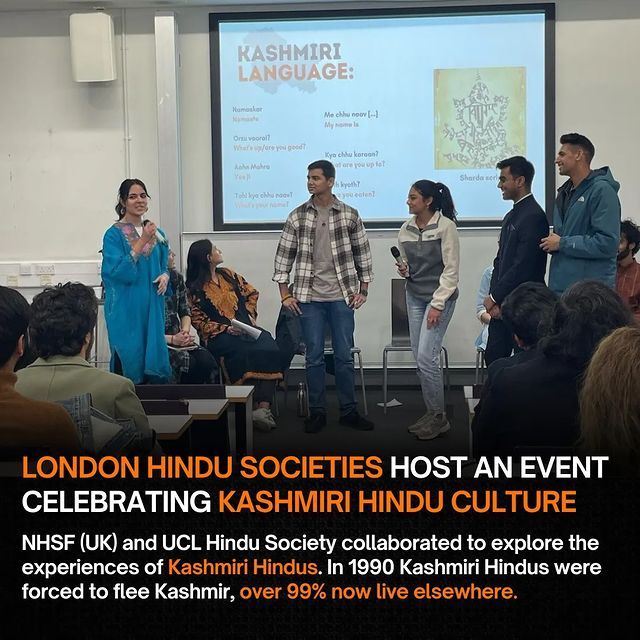On 9th February 2023, Kings College London’s Hindu Society in collaboration with UCL Hindu Society and Imperial Hindu Society hosted an event on Kashmiri Identity at UCL. The evening featured an incredible presentation and Q and A from Kashmiri youth, who’s parents had witnessed and experienced first-hand the exodus in Kashmir during 1990.
The event began with an introduction from Kalakantha Dasa from Akshaya Patra, the world’s largest non-profit Mid-Day Meal programme. The organisation recently opened their first overseas kitchen in Watford to address food insecurities among children, vulnerable adults, universities and food banks. They have also begun working with universities across London to provide students with free hot food on campus, to address the cost of living crisis. They were also the the generous providers of the Kashmiri food served during the evening.
The panel, featuring five young Kashmiri pandits, was truly insightful and highlighted many points which make Kashmir special.
- The prominence of art and culture in Kashmir. Though a small community, there have been many Kashmiris who have gone onto to hold important positions and make an impact worldwide. For example, the first Prime Minister of India Jawaharlal Nehru in 1946 was Kashmiri. Not only have Kashmiris been prominent in politics, but they have contributed to a number of other fields such as Film and Music, with examples of Anupam Kher and Kailash Kher respectively.
- Kashmir is regularly described as paradise on Earth (“Gar firdaus, ruhe zamin ast, hamin asto, hamin asto, hamin ast” which translates to ‘If there is ever a heaven on earth, it’s here, it’s here, it’s here’). It is home to several breathtaking places including Dal Lake, Gulmarg (which has the highest cable cars in the world), Tulip Garden and many beautiful temples including Shankararchaya Mandir which had its initial shrine built in 371BC and Kheer Bhavani Mandir.
- In Kashmir, Kashmiri Shavism is the main practice of Hindus in the region. This revolves around the worship of Shiva and Mother Shakti, as described by one of the panellists. Central texts to Kashmiri Shavism include the Tantraloka and the Shiva Sutras. One interesting point was how the panellists highlighted that Kashmiri Shavism focuses on Trika which is Shiva, Shakti and the Individual, as opposed to the Trimurti (Brahma, Vishnu, Shiva).
- One of the panellists, also shared beautiful poetry from renowned 14th Century Kashmiri poet, Lalleshwari. Lalleshwari was instrumental in using her poetry to engage others in Shavism, Sufism and Buddhism.
- Authentic Kashmiri dishes include Dum Aloo, Nadroo Yakhni and Matz. One salient point mentioned about food, was around why Kashmiri Hindu’s often consume meat dishes. This is because consuming meat was less of a choice in Kashmir due to the harsh climate. It was difficult to grow or import other vegetables, whereas meat was available all year round, and thus to stay healthy it was a necessity. The evening concluded with some of the panellists sharing harrowing experiences as to what their families had been through during the 1990 exodus, as well as their relationship with Kashmir, which is unsurprisingly a painful and complicated one, as mentioned by one of the panellists.
The evening concluded with a beautiful Kashmiri aarti sang by the panellists and audience: Maej Shaarika Kar Daya.
Finally, the panellists shared with us resources and ways in which we can raise awareness about the plight of Kashmiri Hindus as well as learn more about Kashmiri culture. These included books such as ‘Our Moon Has Blood Clots’ by Rahul Pandita, following koayouth and hopecollective on Instagram, listening to ‘Everything Koshur’ podcast, Humans of Genocide on Youtube, ikashmir.net and finally, simply reaching out and speaking to more Kashmiri about their culture and identity.

